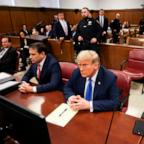The Nightmare on Wall Street: Inside the Trades, Tumbles and Turmoil
The Dow Jones had its biggest single point-drop for 2008, losing 504.48 points.
— -- "Terrible" only begins to describe Monday's disaster on Wall Street, as one bank filed for bankruptcy, another was bought for a song and an insurance giant faced a struggle to stay solvent.
The Dow Jones had its biggest single-point drop for 2008, losing 504.48 points (-4.42 percent) to close at 10,917.51. It was the sixth-biggest point drop in the history of the index, the biggest point drop since the first day of trading after Sept. 11 and the biggest percentage drop since July 19, 2002. The Dow closed at its lowest point since July 21, 2006.
The Dow is down 17.7 percent so far this year and, from its peak in October 2007, the index has dropped nearly 23 percent.
The S&P 500 had its lowest close for the year, losing 59 points (-4.71 percent) to close at 1,192.70, while the NASDAQ lost 81.36 points (-3.60 percent) to close at 2,179.91.
That said, considering the historic proportions the weekend's news, it could have been a lot worse.
To recap, Lehman Brothers filed for bankruptcy, Merrill Lynch was sold to Bank of America, and the world's largest insurance company, American International Group (AIG), is desperately trying to stave off insolvency.
Today's drop in the market came after the federal government made it clear this weekend that it was getting out of the business of providing taxpayer dollars to shore up troubled businesses.
After forcing a sale of Bear Stearns in March and taking on $29 billion in loan guarantees, and then stepping in to rescue Freddie Mac and Fannie Mae only last weekend, the government indicated, by not stepping in to provide funds for Lehman, that enough is enough.
Treasury Secretary Henry Paulson told reporters Monday, "I never once considered that it was appropriate to put taxpayer money on the line in resolving Lehman Brothers."
And President Bush said, "In the short run, adjustments in the financial markets can be painful, both for the people concerned about their investments and for the employees of the affected firms. In the long run I'm confident that our capital markets are flexible and resilient and can deal with these adjustments."
The short term, however, is looking ugly. Financial stocks at the heart of the storm saw big selloffs, with not just AIG and Lehman hitting their lowest stock prices for the year, but even sterling Goldman Sachs falling to an annual low.
After one day of trading, the selloff we saw today could continue through the week.
Asian markets, which were closed today, will open tomorrow and show their reactions to today's selloff. Big losses there could result in further losses in the United States.
The Federal Reserve meets this week to review interest rates. After the past weekend, it's possible that the central bank will lower rates to try to head off deeper losses.
Paulson is due to speak at the Brookings Institution about the housing market.
Goldman Sachs, one of the few giant investment banks still standing, reports earnings before the markets open.
August inflation figures will also be released.




